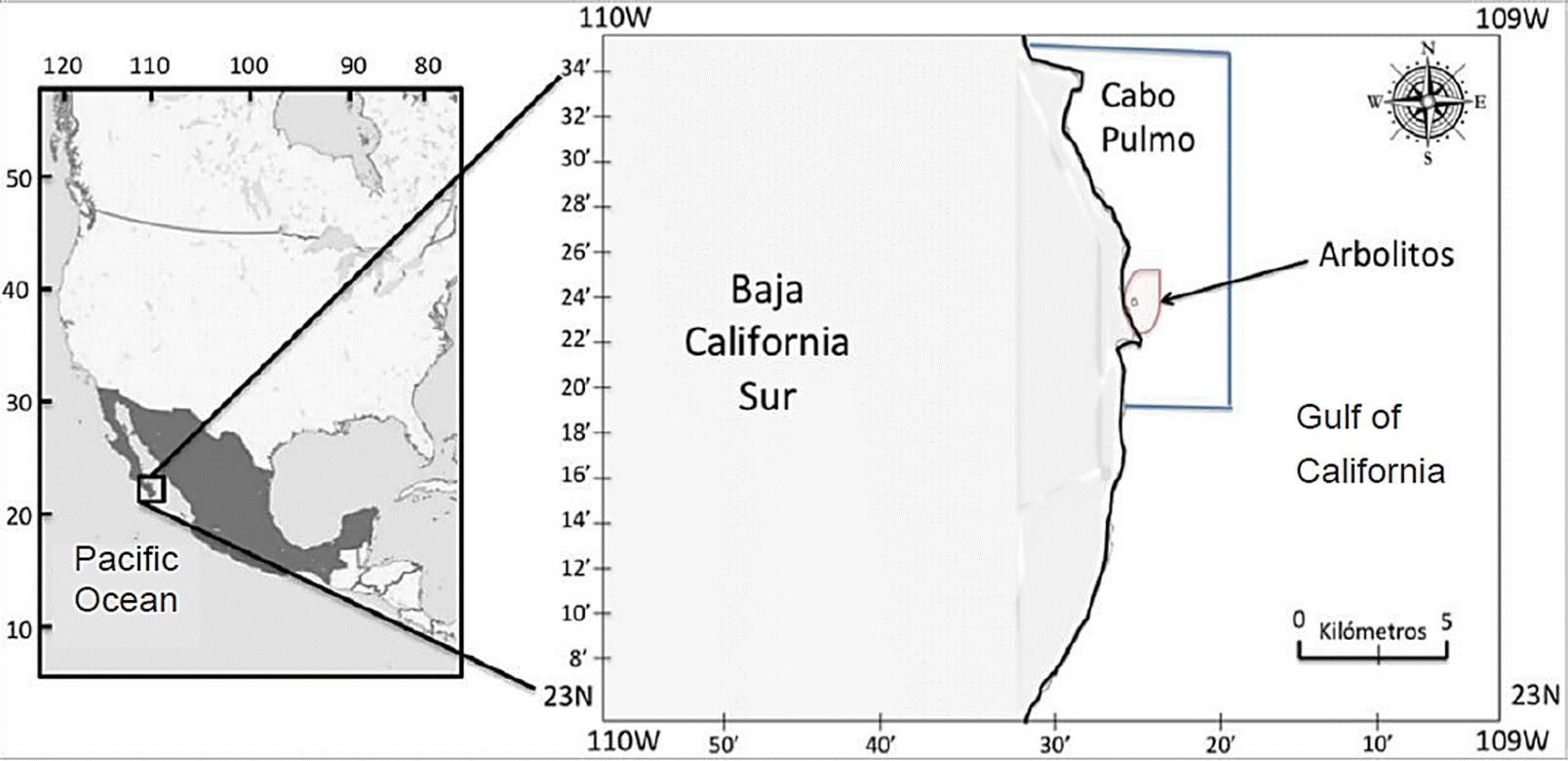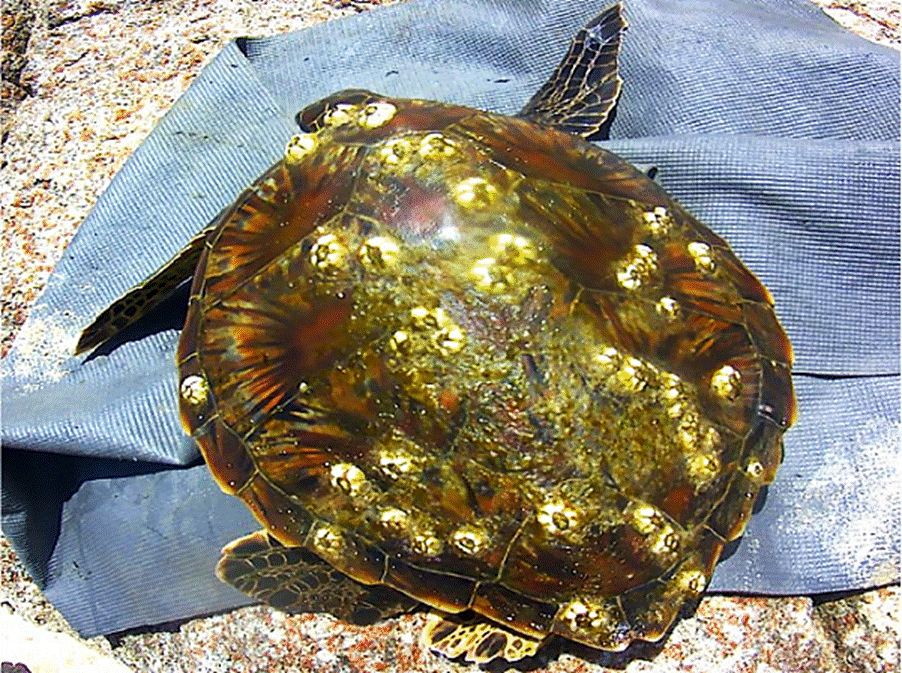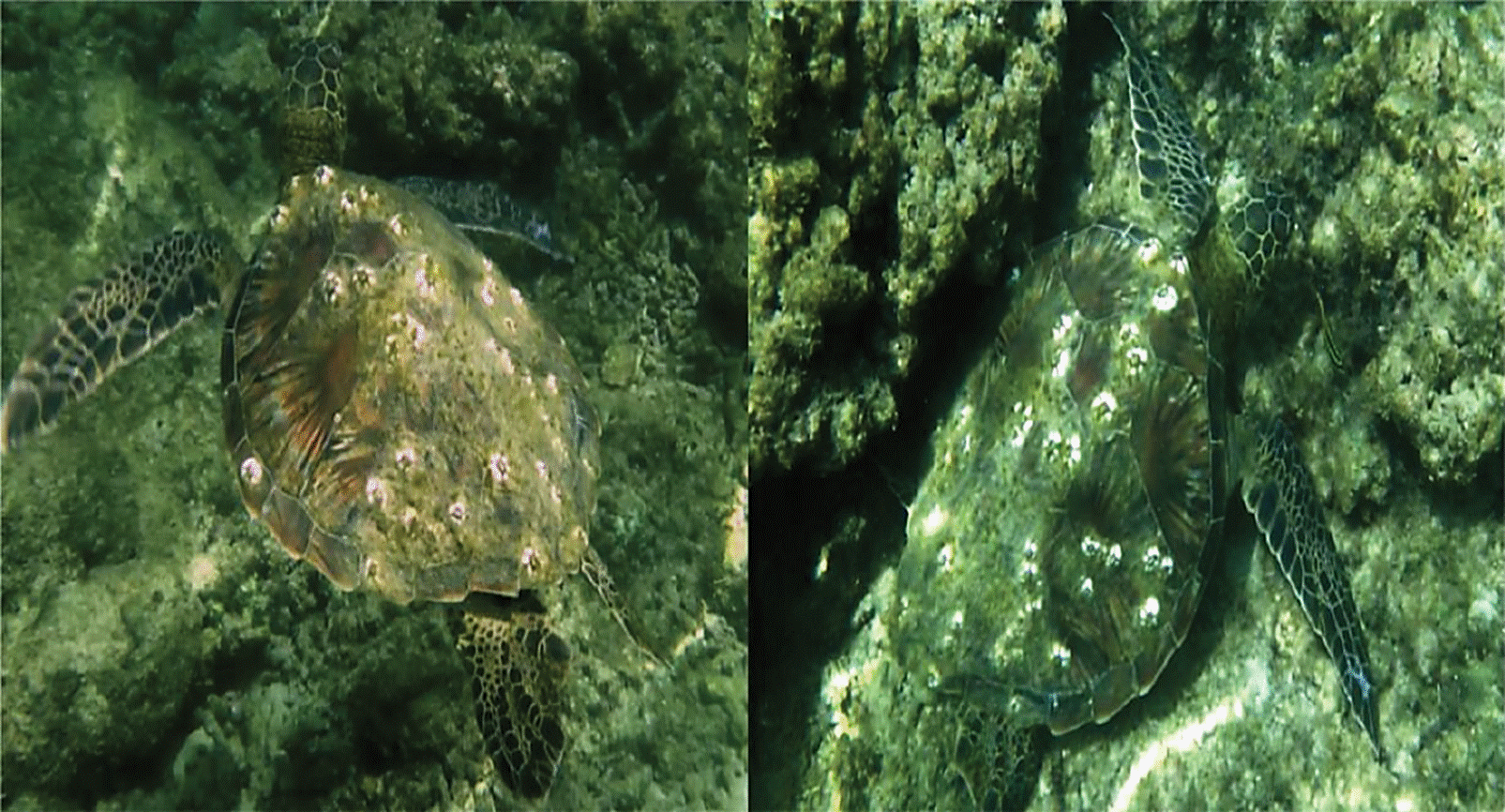Introduction
The Eastern Pacific Green Turtle, Chelonia mydas (Linnaeus, 1758) is listed as Endangered (EN) by the UCIN Red List of Threatened Species (Senko et al., 2010). This species is distributed throughout costal environments along the Pacific Ocean, mainly occupying the areas between the Tropics (Alvarado & Figueroa, 1992). Because it is considered a highly migratory organism, its feeding sites and refuge can be found in several habitats according to its different life stages (Nichols, 2003).
The Gulf of California is both a feeding and a shelter zone for this and other marine turtle species. Within this region, some important feeding zones for C. mydas are: the Los Ángeles Bay (LAB) (Seminoff et al., 2002a; Seminoff et al., 2002b), Loreto (DOF, 2002), and the Espíritu Santo Archipelago Marine National Park (ESMANP) (SEMARNAT, 2014).
Cabo Pulmo National Park (CPNP) is one of the main Protected Natural Areas in the region. Since it was created, it has served as a clear example for conservation, allowing for the recovery of several vertebrate and invertebrate species to take place, such as corals, fishes and even marine turtles, including Hawksbill sea turtle (CONANP, 2006). Incidentally, there have been sightings of C. mydas in the CPNP; nevertheless, there are no documented registries of individuals of this species feeding inside the Park. This article documents for the first time a C. mydas individual feeding in the CPNP through subaquatic photography, as well as its identification and examination.
Material and Methods
CPNP is located in the Los Cabos municipality, between the cities of La Paz and San José del Cabo, between 23°22’30” and 23°30’00” North latitude, and 109°28’03” and 109°23’00” West longitude, on the coast of the Gulf of California (Figure 1). It has a surface area of 7,111 ha of which 99 % is composed by the marine portion and 1 % belongs to the Federal Maritime Land Zone. The prevailing substrate is mainly sandy and coarse, and is composed of silica sand and calcium carbonate particles. The zone is known for its deep and mild-temperature waters throughout most of the year. The Cabo Pulmo National Park is the only coral reef ecosystem in the Gulf of California and it is the coral reef with the northernmost location in the East Pacific. Because of this, it is considered to be a high impact ecological zone at a regional scale (CONANP, 2006).

Figure 1 Cabo Pulmo National Park polygon, located within the Gulf of California. It shows in red the zone of sighting and capture of C. mydas feeding.
On July 17th, 2018 at 12:30 hours pm inside the CPNP on the zone known as Arbolitos (23º24’16.32”N and 109º25’16.44”W) (Figure 1) during a marine supervision, a C. mydas specimen was found feeding. Said organism was photographed with a Ricoh WG-3 digital camera in order to obtain and document evidence of its behavior.
Thereafter, it was captured by free diving. The organism was identified using the identification and sexual dimorphism criteria proposed by Wyneken (2001) and Pritchard & Mortimer (1999), and its age was defined as was proposed by Márquez (2002). Subsequently, it was examined following the methodology of Reséndiz et al. (2018) to evaluate its physical state; the presence of epibiont organisms was observed on its carapace. Later on, its morphometric data was registered: curved carapace length (CCL), curved carapace width (CCW), tail length (TL) and breastplate length (BL) with the aid of a flexible measuring tape and following the procedure described by Bolten (2000). Then, the specimen was tagged on the hind flippers with Inconel 625 tags as per described in the methodology of Balazs (2000). Finally, the organism was released in the zone whence it was extracted.
Results and Discussion
The C. mydas specimen which was found in the CPNP has the following lengths: a CCL of 42 ± 0.5 cm, a CCW of 38.8 ± 0.5 cm, a TL of 5.7 ± 0.5 cm, and a BL of 33.5 ± 0.5 cm. Several anatomical and morphological traits, such as the oval shape of the carapace, its color, the lack of serrated borders, the presence of four lateral plates and five central plates, the rounded shape of the head and the presence of prefrontal scales; allowed for the verification of the species identification as C. mydas (Pritchard & Mortimer, 1999). The organism was classified as a juvenile based on its size (Márquez, 2002) and was decided to be of undetermined sex, due to the lack of sexual dimorphism evidence (Wyneken, 2001). As per the physical evaluation, the C. mydas specimen did not show any evident signs of lesions or clinical manifestations of disease (Reséndiz et al., 2018). The specimen showed a large amount of barnacles on its carapace, which were identified as Chelonibia testudinaria (Figure 2).

Figure 2 Juvenile of C. mydas found in Arbolitos; the great amount of epibionts on the carapace is shown.
The C. mydas specimen was found foraging for macroalgae of the Rhodophyta group on at least two times (Figure 3), which suggests that the Arbolitos region inside the CPNP may be a potential feeding and refuge region for this species.

Figure 3 The Eastern Pacific Green Turtle feeding in the area of Arbolitos, within the Cabo Pulmo National Park.
Reports of feeding sites for green Eastern Pacific turtle in the Gulf of California are generally referred to the sites of LAB (Seminoff et al., 2002a; Seminoff et al., 2002b), Loreto (DOF, 2002), and ESMANP (SEMARNAT, 2014). Although the only published articles correspond to the LAB area, the presence of C. mydas is occasionally reported in the management plans of the different National Parks. This is the case for the CPNP (CONANP, 2006). Nonetheless, there are no registries of activity and behavior of this species in the Park; thus, this here evidence suggests that the area may provide with the optimal conditions for feeding and refuge for this species to undergo the juvenile stage of its life cycle. Records are kept which state that, in the Gulf of California, in its juvenile stage, C. mydas feeds mostly on macro-algae and small invertebrates (Seminoff et al., 2002a; Seminoff & Jones, 2006; Riosmena-Rodríguez et al., 2011). From within the macro-algae group, Seminoff & collaborators (2002a) report genera such as Codium, Ulva, Gracilaria, Gelidium, Halymenia and Laurencia as the main digested contents in the Gulf of California. Said marine macro-algae genera are part of the Chlorophyta and Rhodophyta groups, which is in accordance with what is reported on this paper.
Cabo Pulmo National Park is the only one to have a coral reef in the Baja California peninsula, which has driven a large amount of studies in the area (Reyes-Bonilla et al., 1997; Reyes-Bonilla & Calderón-Aguilera, 1999; Arizpe-Covarrubias, 2004). These, in turn, have been reflected in a favorable conservation state, due to the biomass quantity being exported to surrounding areas and the recovery of the different fish and other invertebrate populations present. Because of this, the CPNP has become one of the most relevant regions in the Sea of Cortez (Reyes-Bonilla, et al., 2014). Given that a different sea turtle species was found feeding in the CPNP, and the fact that it was a juvenile organism, the Park could represent an important feeding and shelter zone for several marine turtle species. Therefore, this information adds to the importance of enforcing the conservation and regulation policies already in place, in order to maintain optimal conditions for the ecosystem and ensure its hold as an ecologically relevant zone.
The documented presence of C. mydas in the CPNP suggests that this species’ distribution spans throughout the Gulf of California, because the southernmost documented region had been the ESMANP. This fact, along with the feeding behavior, suggests a new foraging and safeguard region for this species, which is why a focused study is recommended in order to ascertain both abundance and behavior of said species in the zone, to better comprehend the role of the CPNP in the life history of this organism.











 texto en
texto en 



